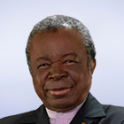Playlist
Show Playlist
Hide Playlist
Ebola: Treatment and Prevention
-
Slides Ebola Treatment and Prevention.pdf
-
Download Lecture Overview
00:00 <b>So the second part is, Ebola treatment .</b> <b>F or more than four decades since the discovery of Ebola in 1976,</b> <b>ebola virus disease has no treatment.</b> <b>But today s ince</b> <b>2022, thanks to the international collaboration,</b> <b>Ebola virus disease is now curable with monoclonal antibodies,</b> <b>including our molecule called ebanga.</b> <b>Monoclonal antibodies 114 that we developed in our laboratory.</b> <b>So the idea of using monoclonal antibodies started in</b> <b>during the outbreak of kikwit.</b> <b>So for the first time, we used a compassionate,</b> <b>compassionate use of convalescent blood to treat Ebola patients.</b> <b>Seven out of eight patients treated with, with,</b> <b>blood from Ebola convalescent were cured.</b> <b>We isolated monoclonal antibodies from a convalescent of Ebola kikwit,</b> <b>capable of neutralizing the Ebola virus in cell culture and in non-human primates.</b> <b>Monotherapy with monoclonal 114 protected macaque monkeys</b> <b>when administrated up to five days after viral inoculation.</b> <b>In a clinical trial conducted during the Ebola outbreak in DRC in 2018</b> <b>-2022, we demonstrated that monoclonal antibodies one went for administration</b> <b>was safe and well tolerated at a dose of 50mg per kilo.</b> <b>Treatment with a single human monoclonal antibodies suggests that a simplified</b> <b>therapeutics strategy for Ebola is possible, and so we conducted a clinical trial</b> <b>comparing the safety and the effectiveness of three monoclonal antibodies and one</b> <b>antiviral. The antiviral was Remdesevir and the monoclonal MAb114,</b> <b>Regeneron and ZMapp, and Regeneron and Monoclonal 114 were declared very active to</b> <b>reduce the mortality in treated patients, and these two monoclonal antibodies were</b> <b>approved by FDA as a treatment, specific treatment of Ebola patients,</b> <b>adult like children. Our monoclonal we call ebanga the Congolese molecule.</b> <b>So ebanga was like the dream of my life is now reality thanks</b> <b>to the commitment and the tenacity of Congolese scientists.</b> <b>The close collaboration with NIH United States and the contribution of Congolese</b> <b>patients and survivors under the aegis of WHO.</b> <b>And what is the prevention of ebola virus, ebola virus disease?</b> <b>As I said, for more than four decades since the discovery in 1976.</b> <b>Ebola virus disease has no vaccine.</b> <b>Today, thanks to the international collaboration,</b> <b>the Ebola virus disease is preventable with two approved vaccine,</b> <b>the Merck rVSV-Zebov -GP vaccine, called ERVEBO,</b> <b>is used for ring vaccination of contacts of contacts.</b> <b>The second is the Johnson and Johnson vaccine that is used for the general population to</b> <b>obtain the herd immunity in the population.</b> <b>To conclude, we have now for Ebola outbreak.</b> <b>We have treatment and we have vaccine to fight against</b> <b>Ebola outbreak in Africa and in the world.</b>
About the Lecture
The lecture Ebola: Treatment and Prevention by Jean-Jacques Muyembe-Tamfum, MD, PhD is from the course Ebola.
Included Quiz Questions
What was the breakthrough that led to the development of monoclonal antibody therapy for Ebola?
- Compassionate use of convalescent blood during the Kikwit outbreak, where 7 out of 8 patients were cured
- Discovery of antiviral compounds that could inhibit Ebola replication in laboratory studies
- Development of synthetic antibodies created through computer modeling techniques
- Isolation of protective proteins from fruit bat reservoirs of the Ebola virus
- Analysis of blood samples from healthcare workers who survived Ebola infection
Which monoclonal antibodies were declared most effective and approved by the FDA for Ebola treatment?
- Regeneron and monoclonal 114 (ebanga) were approved after demonstrating significant mortality reduction
- ZMapp and remdesivir were the first combination therapy approved for clinical use
- Convalescent plasma and immunoglobulin preparations from survivors
- Synthetic antibodies combined with interferon-based antiviral medications
- Monoclonal 228 and favipiravir combination therapy for severe cases
What are the two main vaccination approaches now available for Ebola prevention?
- Ervebo (rVSV-ZEBOV-GP) for ring vaccination of contacts and Johnson & Johnson vaccine for population immunity
- Live attenuated virus vaccine for healthcare workers and inactivated vaccine for general population
- DNA-based vaccine for emergency use and protein subunit vaccine for routine immunization
- Viral vector vaccine for adults and conjugate vaccine for pediatric populations
- Recombinant vaccine for outbreak response and mRNA vaccine for preventive campaigns
Customer reviews
5,0 of 5 stars
| 5 Stars |
|
5 |
| 4 Stars |
|
0 |
| 3 Stars |
|
0 |
| 2 Stars |
|
0 |
| 1 Star |
|
0 |



